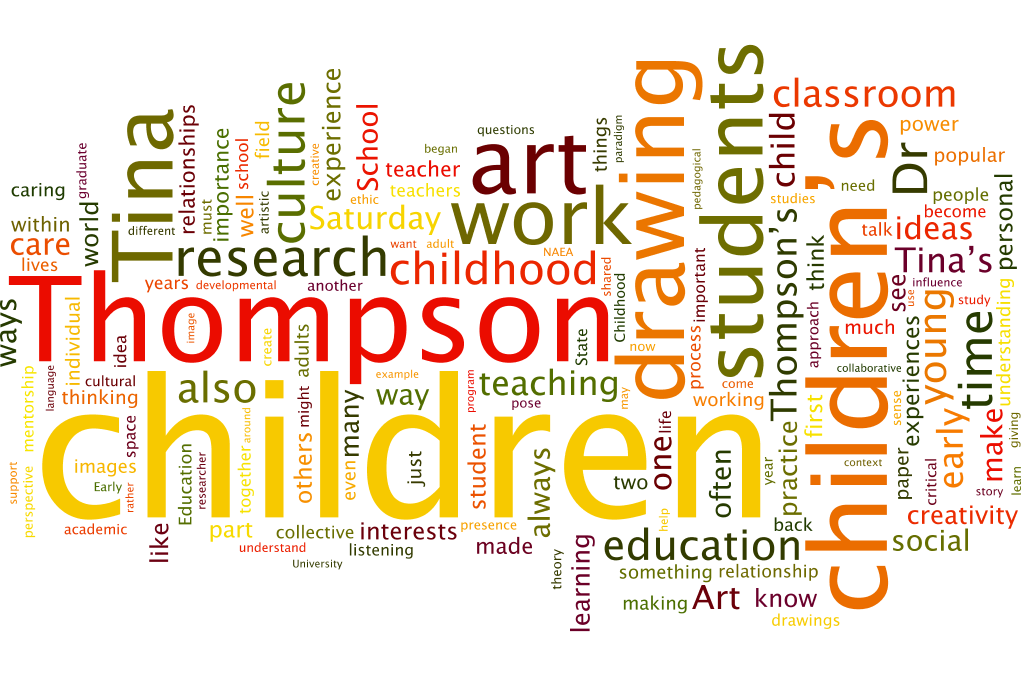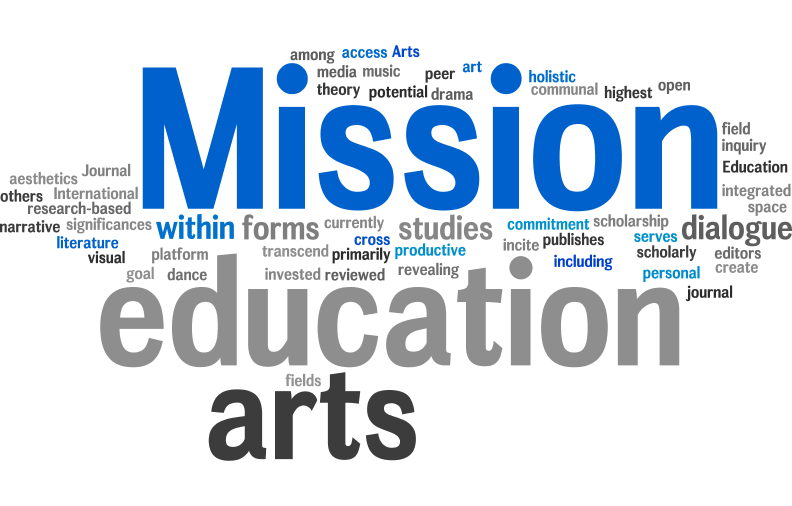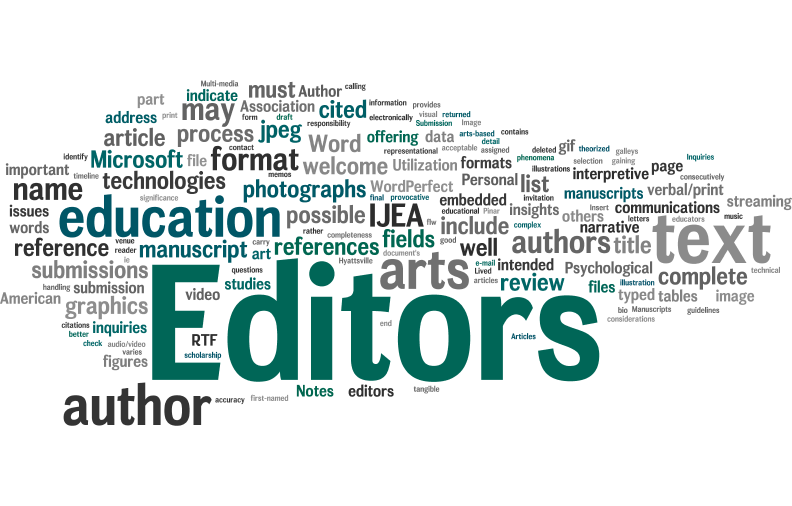| Volume 19 Special Issue 1 | May 16, 2018 |
Special Issue: The Everydayness of Tina
Kristine Sunday
Old Dominion University, USA
Citation: Citation: Sunday, K. (Ed.). (2018). Special issue: The everydayness of Tina International Journal of Education & the Arts, 19(si1). Retrieved from https://ijea.org/v19si1/
Visual Abstract

Editorial
The Everydayness of Tina: An Introduction
Citation: Sunday, K. (2018). The everydayness of Tina: An introduction. International Journal of Education & the Arts, 19(si1.1). Retrieved from https://doi.org/10.18113/P8ijea19si01
Introduction to the Festschrift
When I first learned that my graduate student mentor, Dr. Christine Marmé Thompson decided that it was time to retire, I had mixed emotions. On the one hand, I was happy. I had spent many evenings with Tina (as she is known to colleagues, family, and friends), and her husband, Dr. Dan Thompson, on the patio of her State College, Pennsylvania home, sharing in the intersections between professional and personal lives. I knew that both she, and Dan were looking forward to more leisurely explorations and the slower pace that a life outside the demands of the academy provides. I was of course, also sad. Almost panicked, if I were writing honestly. Tina’s steady hand of mentorship is a constant in my life- an everydayness for me.
In developing this special issue, I wanted to pause and consider this idea of everydayness- what does it mean to recognize someone a part of your everyday landscape? It is something that comes up again, and again, and again from all of us who know Tina and have characterized their relationships with her. Tina has tremendous patience, a great sense of humor, a keen mind, and a commitment to leaving the world in ways better than we found it. These concepts materialized in the ways that Tina approached research, mentorship, teaching, and service. In dialogue with postmodern and poststructural theory, Tina’s scholarship emerged as a critical voice in art education scholarship that helped to shape contemporary views, ideas, and theories about children, art, and artmaking. As a mentor, she seemed unflappable. There was always time in her day for a conversation, a cup of coffee, a quick turn-around-time on dissertation feedback, or crisis intervention. She showed up, always, and without complaint. We, as her students, never felt brushed aside or rushed when it was our turn for Tina Time, a sentiment that runs through the selections in this issue. As a teacher, she was a constructivist, through and through. We make the meaning. There was no doubt about that. She was never one to lecture, but always one to provoke. To be fair, sometimes her constructivist tendencies were maddening when seeking quick answers that could make teaching “easier”, but Tina always had the long game in mind. If you want something to stick, you have to make it yourself. In service, Tina’s commitment to the field forwarded a critical perspective that placed respect for, and agency of children, teachers, and students at the forefront of her work. She was the Studies in Art Education Invited lecturer at the 2015 National Art Education Association convention, in New Orleans, a testament to her contributions to the field. These things about Tina, these ways of being and knowing were a part of my everyday landscape- it made no difference if she was near or far- she was there. But what might that look like now that retirement was on the horizon? Certainly there is no doubt that the impact of Tina’s research, teaching, mentorship and service has left its mark on the field of art education. For those of us who had the privilege of working, thinking, and playing along side of her, her influence is all the more pronounced- for we were part of the making.
To create this festschrift, the authors took time to reflect on different dimensions of Tina’s academic career and identified the influences, lessons, and ways of being that left indelible marks on our own professional careers. Our issue begins with ideas of collaboration and Dr. Patricia Tarr, who traces a history of shared ideas with Tina and the enduring questions about children and their artistic development that emerged from that work. We then turn our attention to Dr. Marissa Sweeney whose discussion of the “power pose” will resonate widely with those who have experienced the wise, calm, and steady presence of Tina. We then explore research and how relationship with Tina provides valuable insights into our own identities and practices of research. To this end Dr. Christopher Schulte considers how adults enter into research relationships with children and the enduring importance of taking young children, and their work, as serious forms of inquiry. Dr. Kristine Sunday invites readers to a discussion of children’s drawing and the enduring importance such discussions have for early childhood education. Next is Dr. Leslie Reich, whose paper considers dialogic nature of theory and practice by bringing a Bahktinian perspective to bear on how Tina’s writing speaks to her own. We then present selections that focus on Tina’s contributions to thinking with/in children’s culture. Dr. Heather Kaplan unpacks the possibilities for a humanist research and theory, and from Finland, Dr. Marlena Mustola reveals the ways that children’s culture serves as an important ready made for young children’s learning in the arts. We last turn to thoughts on teaching and mentorship from Dr. Natalia Pilato who connects Tina’s teaching practices to Nel Noddings ethic of care. We conclude with a brief note of thanks from Dr. Mary Wolf.
As editor for this special issue, and on behalf of its authors, I say thank you to Tina. And to her family, who so generously shared her with us for so many hours, I say thank you, as well. I also would be remiss if I were to ignore the help of my dear colleague, Dr. Heather Kaplan, whose assistance with editing this issue made all the difference in its coming to be.
Special Issue Contents
Once a Year…
—Pat TarrTina Thompson: My Superhero
—Marissa McClureEntering the Cultural Milieus of Children’s Drawing: Complicated Proximities
—Christopher M. SchulteArt Education and Beyond: Drawing and Young Children in Early Childhood Education
—Kristine SundayA Lifetime with Children and the Subtle Subversion of Respecting the Child
—Heather KaplanNot Those Seven Annoying Dwarfs – Again! Collective Creativity in Children’s Artistic Production
—Marleena MustolaPedagogy of Care: Embodied Relationships of Teaching and Mentorship
—Natalia PilatoA Note of Thanks
—Mary WolfComposing a Beautiful Life: Homage to Tina
—Liora Bresler




